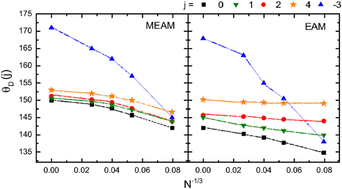Systematics of vibrational properties of Au nanoparticles: a molecular dynamics approach
Abstract
This paper reports the results of a Molecular Dynamics (MD) study of the vibrational properties of spherical Au nanoparticles with a number of atoms (N) varying in the range 1985 ≤ N ≤ 53 117. The LAMMPS code is adopted to calculate the vibrational density of states (VDOS), represented by D(ω) versus ω function. Two interatomic potentials, an EAM and a MEAM are used. The first part of the work is devoted to the D(ω) versus ω relation of macroscopic Au, which is obtained by MD simulations as well as by a density-functional-theory calculation using the Vienna Ab Initio Simulation Package and the PHONOPY code. Additional experimental and theoretical results on the VDOS of Au are used to compare with the present results. Next, the effect of changing N and the interatomic potential upon the VDOS of the nanoparticles is established. In particular, the effect of the surface vibrational modes upon the results is discussed. Various moment frequency parameters ωD(j) expressing averages of the D(ω) versus ω function are evaluated, and expressed as Debye temperatures θD(j), using standard relations. Attending to the relevance of these quantities in the description of the thermodynamic properties of macroscopic solids, values of θD(j) corresponding to j = −3, 0, 1, 2 and 4 are reported. On this basis, a picture of the systematic effects of changing N upon the θD(j) values is established both for the EAM and the MEAM potential. In addition, various interrelations between the θD(j) values for nanoparticles are presented. In particular, remarkably simple correlations are reported between the average quantities θD(0), θD(1), θD(2) and θD(4) and θD(−3) i.e., the Debye temperature which accounts for the low-frequency part of the spectrum. Finally, a discussion is reported of the relation between θD(−3) and other properties that are usually adopted as a measure of cohesion in macroscopic solids. To this aim, new correlations involving the nanoscopic counterpart of the temperature of fusion of macroscopic elements as well as the cohesive energy for Au nanoparticles are presented.



 Please wait while we load your content...
Please wait while we load your content...